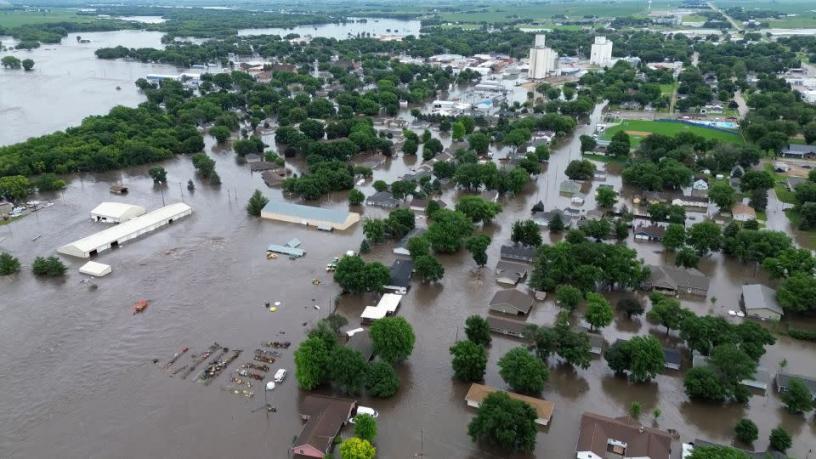Iowa Gov. Kim Reynolds flew over the flood-ravaged state Saturday with federal officials. Reynolds said she is working with federal agencies on recovery efforts.
Millions of people across the US are still trudging through a record-setting heat wave that is shifting to the mid-Atlantic, while many Americans – including in New Mexico, Iowa, Minnesota and South Dakota – contend with “catastrophic” flash flooding this weekend.
• Heat wave shifts to mid-Atlantic: As heat alerts persist for over 100 million people over the weekend, the extreme heat risk will spread from the Ohio Valley on Saturday to the mid-Atlantic on Sunday. Highs across the Ohio Valley and mid-Atlantic have been 10 to 15 degrees above average. “An intense heat wave will continue across the mid-Atlantic, where record high temperatures are likely,” the National Weather Service said Saturday. “Numerous record-tying/breaking highs are possible,” the agency added. In the West, triple-digit temperatures are possible in central and southern California, Arizona and Utah.
• Temperatures break records: Triple-digit heat broiled Baltimore and Washington, DC, on Saturday. The nation’s capital hit the 100-degree mark Saturday — the first time that’s happened since 2016. It’s also the first time DC has recorded a temperature that high this early in the summer since 2012. Baltimore also hit 101 degrees, breaking the daily record of 100 degrees set back in 1988. The combination of this heat coming early in the summer season and persisting over several days “increases the level of heat stress for those without reliable air conditioning,” the weather service said.
• Flooding prompts evacuations in Iowa: In Rock Valley, Iowa, all homes north of Highway 18 were evacuated amid high floodwaters Saturday. “I cannot even believe what I’m seeing right now,” said Daniel Heitritter, who evacuated his neighborhood in Spencer on Saturday. As water in his home reached shin-deep, he flagged down a boat to come pick him, his wife and cat up, he said.
• Iowa governor issues disaster proclamation: On Saturday, Iowa Gov. Kim Reynolds issued a disaster proclamation for 21 counties in northwest Iowa and directed all available state resources to assist Rock Valley and other communities in response to “catastrophic flooding.” A level 3 of 4 risk of excessive rainfall is in place over southern Wisconsin and northeastern Iowa.
• People rescued from rising water in South Dakota: In Sioux Falls, South Dakota, nine people were rescued from rising water due to heavy rainfall, according to City Emergency Manager Regan Smith. Emergency personnel responded to five stranded drivers, 30 vehicles stalled in water, 10 calls regarding water problems and 75 traffic accidents, according to Smith. City of Sioux Falls Mayor Paul TenHaken on Saturday signed an emergency declaration in response to the flooding. The cumulative rainfall amounts for the Sioux Falls region range from 6.5 to 8 inches over the last 72 hours, TenHaken said.
• Emergency flood operations readied in Minnesota: Parts of Minnesota were under flood warnings Saturday night, prompting Gov. Tim Walz to declare an emergency authorizing the Minnesota National Guard “to be available to provide support for emergency flood operations as areas across the state experience extreme flood conditions,” the governor’s office said. Water in lakes Tetonka and Sakatah has reached “uncontrollable” levels. “Residents have been evacuated and the flood has already caused significant damage,” the governor’s office said. “Intense rain has had catastrophic effects. Flooding has left entire communities under feet of water, causing severe damage to property and numerous road closures,” Walz said in a statement.

• New Mexico residents to return home after wildfire: The Salt and South Fork blazes in New Mexico have together burned over 24,200 acres. The South Fork Fire was 26% contained and the Salt Fire was 7% contained as of Saturday night. Ruidoso residents will be allowed to return to their homes Monday, and officials advised them to bring at least a week’s worth of food and drinking water as grocery stores are not operating at full capacity. Although rainfall in the area could help with fire suppression, it can also cause flooding as well as mud and debris flows in the burn scars. Meanwhile, the FBI is offering a reward of up to $10,000 for information leading them to the cause of the wildfires.
Flooding threat in northern New England on Sunday
Showers and thunderstorms are forecast this weekend from New England through the Great Lakes and into the Upper Mississippi Valley, according to the National Weather Service. There is also an excessive risk of rainfall in the Upper Midwest on Monday and Tuesday.
On Sunday, storms are possible across New England with a level 3 of 5 risk of severe storms covering portions of Vermont, New Hampshire, and Massachusetts. The region is facing the potential for damaging winds, a few tornadoes, and isolated hail, according to the Storm Prediction Center.
A lower level severe weather threat extends southwestward though the mid-Atlantic, Ohio Valley and Tennessee Valley, according to the weather service. Rainfall in northern New England will bring a slight risk of heavy downpours and scattered flash flooding.

